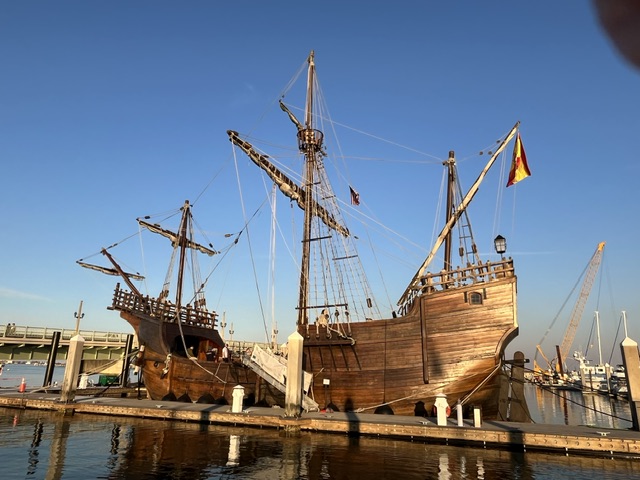
This nao Trinidad was the flagship leading the Magellan-Elcano expedition on the first around-the-world voyage.
Trinidad Spanish for "Trinity" was the flagship captain of Ferdinand Magellan's voyage of circumnavigation. Unlike Elcano's Victoria, which returned to Spain sailing across the Indian Ocean, Trinidad tried and failed to sail east across the Pacific to New Spain or modern-day Mexico.
Trinidad was a nao (ship) of 100 or 110 tonels with square sails on the fore and main masts and a lateen mizzen. Its original crew was 61. After Magellan's death and the burning of the Concepcion, Victoria, and Trinidad the San Antonio and the Santiago being lost earlier reached Tidore on 8 November 1521.
In mid-December, both ships attempted to depart loaded with cloves, but Trinidad almost immediately began to leak badly. Inspection showed that the problem was serious. It was agreed that Victoria would leave for Spain and Trinidad would remain for repairs.
Magellan's expedition circumnavigated the globe for the first time opening new routes, connecting oceans and continents and the people of Argentina, Brazil, the Philippines, Indonesia, and many other nations.
It set sail from, Seville, Spain in 1519 crossing the Pacific Ocean and making it a historical world voyage.
Christopher Columbus used a whipstaff to steer. People assume he used a wheel, which would have been like a “piece of cake.”
The sailors of olden times were tough as nails. The Nao Santa María had four masts holding the foresail, the top, and the mainsail formed by a course and two bonnets, the mizzen lateen sail, and the spritsail on the bowsprit.
She had a whipstaff as a steering system and carried two auxiliary rowing boats on board.
What’s interesting is that it uses a whipstaff to steer. That’s how Magellan’s ships were steered before the invention of the ship's wheel. It’s like a tiller and was used on European sailing ships from the 14th to the 17th century.
So difficult, that it took several sailors to control it during rough, windy, and choppy waters out at sea.
St. Augustine is a city on that lays claim to being the oldest in the U.S., and is known for its Spanish colonial architecture as well a spectacular Atlantic Ocean waterfront. Founded in September 1565 by Don Pedro Menendez de Aviles of Spain, St. Augustine is the longest continually inhabited European-founded city in the United States – more commonly called the "Nation’s Oldest City." Stroll the narrow lanes, enter the many museums, and visit historic landmarks such as Castillo de San Marcos, Ponce de Leon's "Fountain of Youth," and the Oldest Wooden Schoolhouse.
By: Professor Elena B. Odio, in St. Agustine